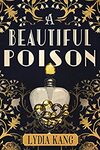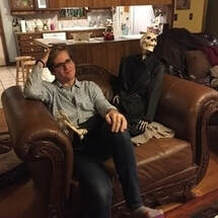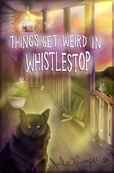Sacred Chickens
Menu
SACRED CHICKENS
 A Beautiful Poison Author Lydia Kang by Jarad Johnson I recently read the book, “A Beautiful Poison.” When I first picked it up, I thought it sounded like an antebellum novel. I kept picturing a woman in a large hoop skirt saying in an overwrought southern accent saying, “His love was a beautiful poison.” That didn’t happen, but it shows why you should be very careful what you name your novel. Especially around me. This book is a lot of things – and not other things, like full of hoop-skirted women - but at its core it’s a murder mystery. It centers around a group of childhood friends, and someone is killing the people that are close to them. It starts at a party, where a young woman is found dead on the floor; she has in all likelihood been poisoned. It’s set in New York in 1918, just after the Gilded Age and before the Great Depression, a time of opulence, grandeur, and scientific discovery. It’s interesting how many novels set in this general period tend to aggrandize it and view it through rose colored lenses. They talk about the flappers, the parties, and generally how much fun people were having then. This book offers a different lens. It has a distinctly morose and gritty overtone, which fits in well with the story. It shows the darker and more everyday side of New York during that time. Let’s talk about murder, shall we? As Morticia Addams would say, “Salt, pepper, or cyanide?” Pick your poison, dearies. The murderer in this book is certainly discerning in the poison department, killing a number of people, and keeping the main characters guessing up until the very end. I was kept guessing as well. At every twist and turn, you think you know who the killer is, and might even have decided who they are, but you’ll most likely be proven wrong. That’s a sign of a good mystery, and quite refreshing. You know, oftentimes we view murder mysteries as simplistic. Sometimes that’s why we love them because they’re comforting and safe. Sometimes, a predictable ending allows the author to do other things. I was told once that, “people don’t read mysteries and romance for the ending, they read it for the middle.”By using this method, the author is allowed to explore topics in detail. The reader is allowed a visit to a fantastic locale. However, Kang managed to do both. She explored complex issues and kept the suspense going. I’m interested to see more from this author, because I’m impressed so far. If I had one critique of this book, it’s that it was a little slow in the middle. While the murders are happening all around them, it sometimes felt like the main characters were just walking around, waiting for another murder. Although, to be fair, there’s only so much investigative work they could have done. But I think I would walk around with dread in my heart every day, and I just didn’t get that here. I admit that I’m a nitpicker with too much time on his hands, but what else are reviews for, if not nitpicking? One of the more pressing issues of this book centers around a character named Allene. She is the daughter of a wealthy father, and the first person who had someone they knew murdered. She has a brilliant mind for chemistry and science, and her intelligence is often stifled by the insecure and overbearing male figures in her life. Her father and her fiancé seem to want her to sit still and basically be an accessory. She is often not taken seriously, talked over, and talked down to, which is ironic considering she has more to offer than most of the men around her. It’s nice that this wasn’t glossed over. Women were (and too often, still are!) treated as less than. They were/are, regarded as children who couldn’t take care of themselves. They were viewed as not only unequal to men, but subhuman almost. They were property and dolls for their husbands to prop up. I found a good deal of resonance in the way Allene was treated, as I’ve witnessed that behavior many times, in a variety of places. Now, that’s not to say Allene was perfect. Many times, she acted selfishly and without thought to the people around her. She was often in a position of privilege and behaved callously to those who were not. It was an interesting juxtaposition, and she is often a character who displays a complex personality. But this makes her an interesting and realistic character, not the two-dimensional prop that her father and fiancé seem to think she is. Now, to the issue that stuck with me the most. Let me set a scene for you: A new virus that can’t be controlled, mass death, panic and fear pervading every day and masks being worn to protect people. Sound familiar. Yeah. It was so eerie reading about the Spanish influenza in this book- it felt like I could’ve been reading about this month. And of course, there have been comparisons made between the two viruses, but it made for an odd reading experience. There could be books set in this time period when we’re fighting a pandemic. That’s absolutely wild to me. The question I kept asking myself was, “would I even have noticed the influenza aspect of this book if I hadn’t read it during the pandemic?” Probably not, of course. The same book can resonate differently in different times, and I was just struck by how much it sounded like our new normal, over a hundred years later. It is sort of always in the background of the novel. You hear people start to talk about it in passing, then it slowly creeps more and more to the forefront. It was always there, and always ominous. I’ll ask again, sound familiar? Overall, this book really stuck with me. Not only have I been reading about the pandemic of 1918, but the masterful way in which the story was told. I’m definitely going to be reading more from this author, and I think you should too! Everyone can appreciate a good story.  Bio: Jarad recently graduated from college at MTSU, loves tea and coffee, and tries to spend every spare second reading. He has been a fervent gardener for 6 years and is fascinated by all related topics and has spent the last several years writing about this passion. He believes that nature is our greatest teacher. He majored in English with a concentration in literature and plans to pursue and master’s degree in Ecocriticism.
0 Comments
Leave a Reply. |

Click Photo above to buy ebook or paperback from Amazon.
Here's the link to Barnes and Noble Or order through your favorite independent bookstore! Categories
All
|
 RSS Feed
RSS Feed